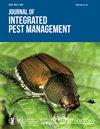Needs Assessment for Corn Insect Pest Management in Iowa
IF 2.7
3区 农林科学
Q1 ENTOMOLOGY
引用次数: 1
Abstract
Corn, Zea mays L. (Cyperales: Poaceae), production is essential to Iowa’s economy and provides food, feed, and fuel beyond the state. Farmers face a number of challenges in corn production, including insect pests, and understanding farmers’ perceptions and concerns is critical for extension personnel to provide adequate and relevant programming. The Iowa State University Agriculture and Natural Resources Crops Team conducted a survey of Iowa farmers and agribusiness professionals during the 2019–2020 extension season. The goal was to understand farmer perceptions of corn pests and whether farmers experienced challenges with resistance to Bt traits or insecticides. Additionally, we aimed to realize farmers’ confidence in developing resistance management plans and discussing those needs with their input suppliers and advisors. Our survey revealed that northern corn rootworm, Diabrotica barberi Smith & Lawrence (Coleoptera: Chrysomelidae), was the pest of greatest concern across the state. People were generally more concerned about belowground Bt trait performance than aboveground traits, though only 12% of respondents reported Bt trait failure for corn rootworms. In general, people were not concerned about the performance of seed treatments or soil- or foliar-applied insecticides. Farmers generally felt very confident in developing a resistance management plan and discussing their needs with their advisors. The results of this survey will be used to target extension programming throughout the state and increase confidence for farmers and agribusiness employees to discuss resistance management plans together.爱荷华州玉米病虫害管理需求评估
玉米是爱荷华州经济的重要组成部分,为该州以外的地区提供食物、饲料和燃料。农民在玉米生产中面临许多挑战,包括虫害,了解农民的看法和关切对于推广人员提供充分和相关的规划至关重要。爱荷华州立大学农业和自然资源作物小组在2019-2020年推广季节对爱荷华州农民和农业综合企业专业人士进行了一项调查。目的是了解农民对玉米害虫的看法,以及农民是否遇到了对Bt性状或杀虫剂产生抗性的挑战。此外,我们的目标是实现农民对制定抗性管理计划的信心,并与他们的投入物供应商和顾问讨论这些需求。调查结果显示,北方玉米根虫(Diabrotica barberi Smith & Lawrence)是该州最受关注的害虫。人们普遍更关心地下Bt性状的表现,而不是地上性状,尽管只有12%的受访者报告玉米根虫的Bt性状失败。一般来说,人们并不关心种子处理或土壤或叶面施用杀虫剂的效果。农民普遍对制定抵抗管理计划和与顾问讨论他们的需求非常有信心。这项调查的结果将用于全州范围内的目标推广规划,并增加农民和农业综合企业员工共同讨论抗药性管理计划的信心。
本文章由计算机程序翻译,如有差异,请以英文原文为准。
求助全文
约1分钟内获得全文
求助全文
来源期刊

Journal of Integrated Pest Management
Agricultural and Biological Sciences-Insect Science
CiteScore
5.80
自引率
3.60%
发文量
24
审稿时长
25 weeks
期刊介绍:
Journal of Integrated Pest Management is an open access, peer-reviewed, extension journal covering the field of integrated pest management. The Editors-in-Chief are Dr. Marlin E. Rice (formerly with Iowa State University) and Dr. Kevin L. Steffey (formerly with the University of Illinois). The journal is multi-disciplinary in scope, publishing articles in all pest management disciplines, including entomology, nematology, plant pathology, weed science, and other subject areas.
 求助内容:
求助内容: 应助结果提醒方式:
应助结果提醒方式:


